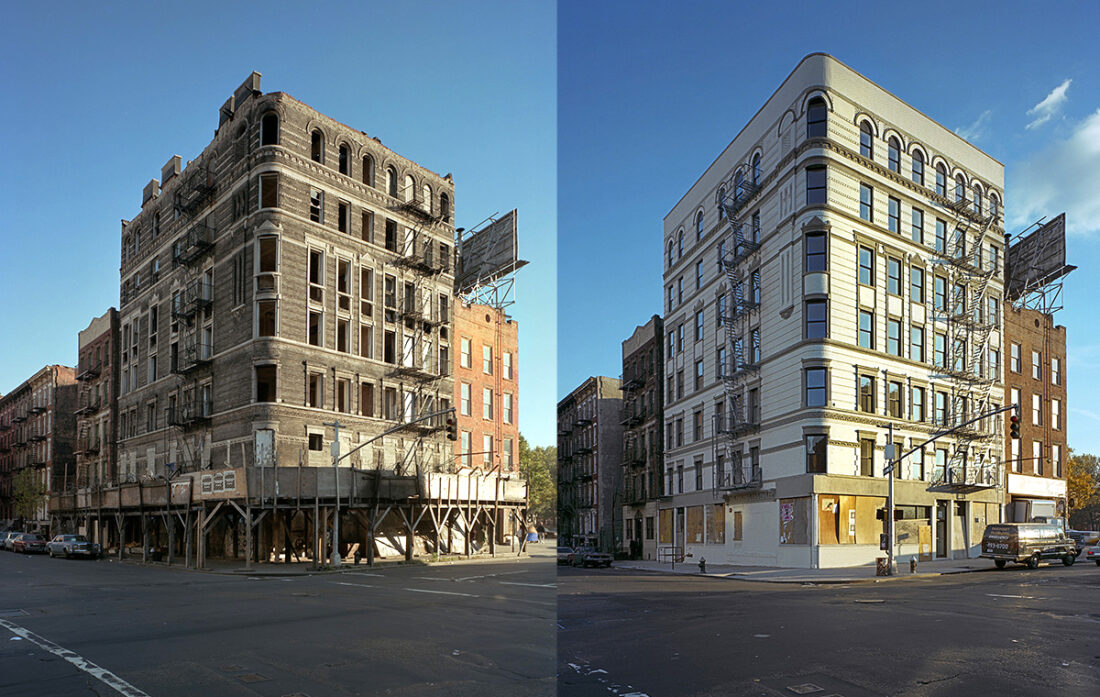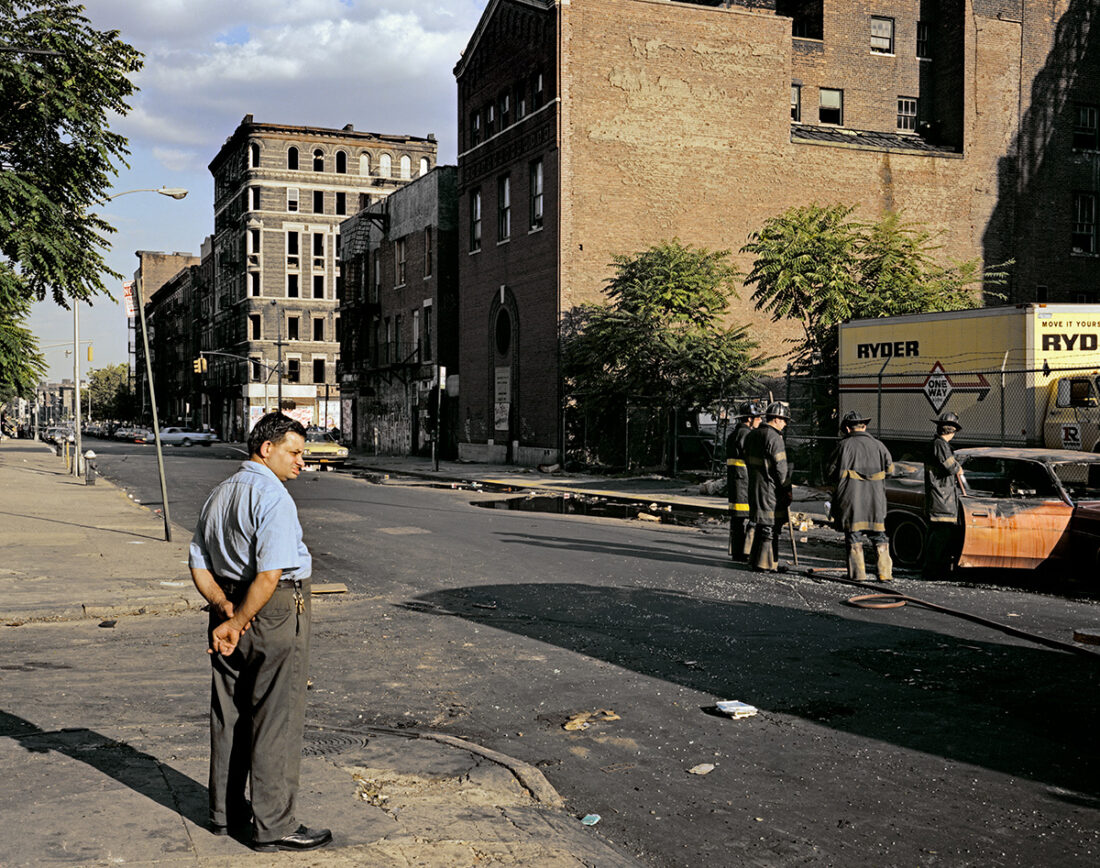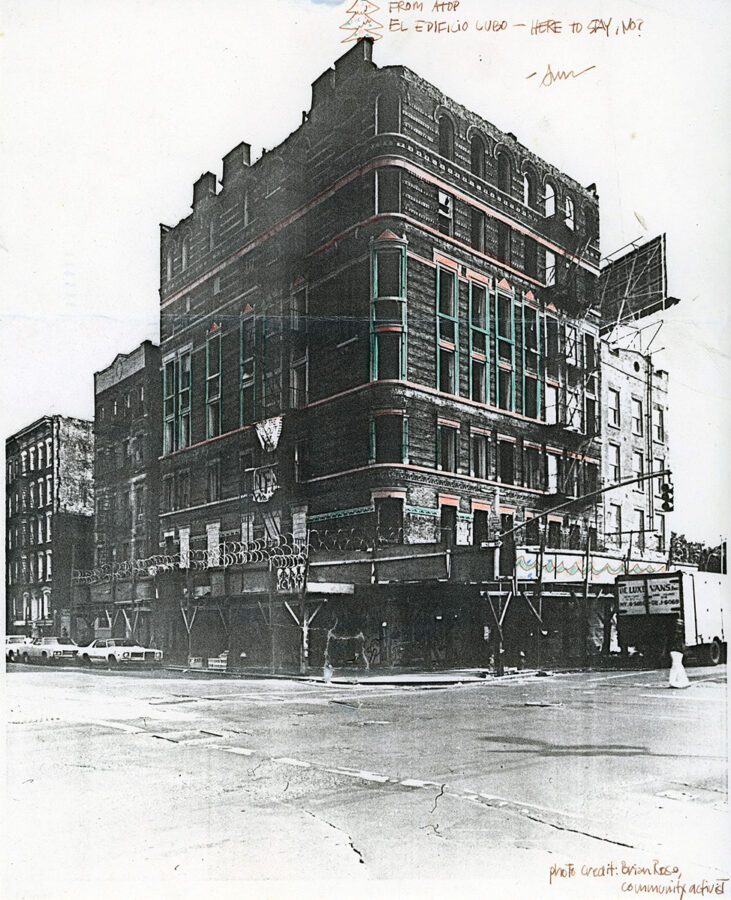
The Cube Building, Second Avenue and East 1st Street, 1985 and 1987 – © Brian Rose
The Cube Building
Things got so bad in the 1980s that the city began offering buildings to developers for $1. Of course, the offer came with conditions, but imagine anything in New York going for a dollar today. The Cooper Square Committee, a housing organization led by the charismatic activist Frances Goldin opposed the giveaway of the Cube Building, a crumbling square-shaped tenement with a collapsed roof at the corner of Second Avenue and East 1st Street. I was a volunteer member of the steering committee of Cooper Square, located on East 4th Street, just a few blocks away. It was 1985, a time of much turmoil on the Lower East Side. AIDS cases were rapidly exploding and discarded crack vials on the street signaled a new and disturbing trend.
We sent angry letters to politicians and held demonstrations protesting the pending sale of the Cube Building, but I was convinced we would fail without a more practical solution. Paradoxically, while derelict buildings were being sold off, the city faced a mounting crisis of homeless families, women with children, not the usual “Bowery bums” or the single individuals who lived in SRO hotels. Responding to political pressure, New York state established a capital program for projects designed to house homeless families. As soon as I heard about the state program, I seized upon the idea of using it to rehabilitate the Cube Building for homeless families. As I recall, it took some doing to convince others that going for the money might be a stronger play than carrying signs in the street.

And there was another little problem. We had no standing as an independent nonprofit to apply for the money. We did not have, in city government parlance, site control. The head of HPD (Housing Preservation and Development), Tony Gliedman, an Ed Koch appointee, was not going to give it to us, but there was a young deputy commissioner, Joe Shuldiner, who met with us, listened to our pitch, and granted us a very narrow window of a few weeks to apply to the state for funding. He may have stepped a little out of line at HPD – perhaps – but he definitely stepped up for us in a big way.
We put together a budget for the Cube Building that was entirely smoke and mirrors. It depended on a million dollars of state money, a vague amount of city participation, and several hundred thousand dollar’s worth of sweat equity. The idea was that the tenants selected for the project would perform construction tasks to round out the financing of the renovation. We knew, of course, that this was ludicrously unrealistic.
When I got involved with the Cooper Square Committee, I was well aware of its role under Frances Goldin’s leadership in stopping Robert Moses from demolishing much of the East Village to build public housing, and I knew that she was instrumental in preventing Moses from running an expressway across Lower Manhattan. So, I had read “The Power Broker,” Robert Caro’s epic portrayal of the rise and fall of Robert Moses, and learned a lot about how things work in this city. There was one paragraph that stuck with me:
Misleading and underestimating, in fact, might be the only way to get a project started. . . . Once they had authorized that small initial expenditure and you had spent it, they would not be able to avoid giving you the rest when you asked for it. . . . Once a Legislature gave you money to start a project, it would be virtually forced to give you the money to finish it.
I knew that if we could get the state to give us money to do the Cube Building, the rest of it would fall into place. “You don’t give money back once you’ve got it,” I remember saying. And so, we packaged a largely fictitious budget proposal and applied for the state money. What I did not fully understand at the time was that Frances Goldin had friends in the agency we were applying to, and our chances of success were better than I knew. That said, I do not believe she had any idea how far out on a limb our proposal actually was. Accordingly, she was calm and confident when we met with state officers in the World Trade Center to outline our proposal. I, on the other hand, was in total panic and feeling physically ill.
The meeting turned out to be a piece of cake – they never asked us to justify our numbers. They had already decided to award us a grant of $1.2 million for the rehabilitation of the Cube Building. We all shook hands with broad grins on our faces, and I realized, somewhat to my surprise, that these supposedly faceless bureaucrats who worked in a fluorescent-lit office in the World Trade Center were as excited as we were to be part of something positive, maybe even something great.
Unfortunately for me, the butterflies I had come to the meeting with had developed into a full-blown bout of food poisoning, and I fled the meeting by myself, grabbing a cab in front of the Vista Hotel, urging the driver to get me back to East 4th Street as quickly as possible. Heading uptown, I couldn’t suppress the nausea any longer, threw some money at the driver, and stumbled out on the corner of Houston and Bowery, vomiting on the street amidst a scattering of disheveled men sprawled on the pavement. The only good thing I can say about the situation is that no one noticed.
And things did fall into place. The city was forced to accept that we had secured the money to start the project, and they, grudgingly chipped in the rest of what ballooned into a $2 million outlay, due in part to the shady low-bid contractor we were forced to work with. There was, of course, no sweat equity component unless you count the untold hours we put into the proposal and the untold hours we put into supervising the construction and selecting the tenants for what was the nation’s first nonprofit coop for homeless families. Val Orselli, director of Cooper Square, and Ann Ostrander, a recent Columbia graduate on our staff, did the lion’s share of the work.

Two years later in 1987, at the dedication of the building held on the sidewalk on Second Avenue, I was pleased to see Joe Shuldiner, who had moved to a job with the New York City Housing Authority. He later became director of the housing authority of Los Angeles, and then Chicago. I said to him, somewhat apologetically, that I was sorry the project ended up costing the city so much more than we had initially proposed. His reply was, forget about it; you got it done; these people have a place to live. Forty-five years later, the Cube Building remains a low-income coop.